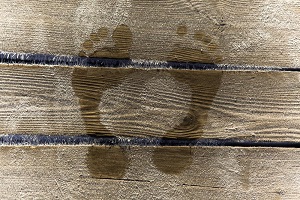How to Manage Chilblains During the Winter

If the cold weather this January and February is causing you itchy feet and there are small, red swellings around your toes which often become quite painful, then you may be suffering from a common condition called chilblains or pernio. These can occur on your hands and face as well as your feet and often affect those who work outdoors during the winter as well as elderly people or diabetics who are more susceptible to the cold because of poor circulation.
What are Chilblains?
When you suffer from chilblains you’ll soon notice because your hands or feet will start burning or itching, a feeling that intensifies when you step into a warm room from the cold outside. You’ll also see a redness to the skin and in more extreme cases find the skin cracking and sores developing. This can be particularly painful on areas such as the feet.
When it gets cold, the small blood vessels in your feet and hands constrict but when you suddenly move into a warm area a quick expansion occurs, often causing pain or itching. People with poor circulation are likely to suffer more than others but you may well see the effects when you simply run your hands under a hot tap once you have been out in the cold.
Much obviously depends on the extremes of hot and cold that you are subjected to and there are any number of situations where you might be affected. One comes from rapid changes in temperature but another is over exposure to damp environments. There may also be dietary influences and changes in your hormonal balance that mean you could be more prone than other people.
How to Prevent Chilblains
If you suffer from poor circulation or are likely to get chilblains, then keeping the whole body warm, as well as your feet and hands, is key to making sure you reduce the risk of this particular condition. If you do happen to get chilblains, it is important not to scratch them as this may exacerbate it and cause it to get worse. Using a soothing lotion such as calamine or witch hazel can help in the first instance.
If chilblains develop into something more severe, they can begin to crack the skin and become ulcerated which obviously causes more of a problem. In these instances, particularly if you suffer from a condition such as diabetes, it is always important to seek the help and advice of an expert.
Your pharmacist may recommend an over-the-counter solution for less troublesome cases but consulting your doctor or seeing a qualified podiatrist who knows how best to manage the condition is often the best solution. This is important particularly if you are diabetic or elderly as there may be other factors that need to be taken into account when assessing your condition.
A podiatrist should be able to treat the current problem effectively as well as suggest ways in which to minimise your risk of developing chilblains in the future. If you are elderly and suffer from poor circulation this could involve having regular checks during the cold winter months to make sure your feet are in good condition. At Beauchamp Foot Care, you can talk to a qualified podiatrist and discuss your chilblain problems so that you can stay healthy this winter. Call us today on 020 7225 0794 or use our contact form.
All information on this website is for general guidance only and is not intended as a substitute for the personal medical advice of health care professionals or your own doctor.
